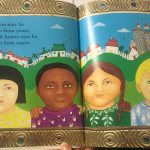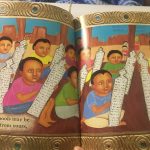Author(s): Mem Fox
Illustrator/Photographer: Leslie Staub
Publisher and Year: Harcourt in 1997
Number of Pages: 26
Genre: Fiction
Analysis:
This book begins with the main character telling the reader, who they assume is a “little one,” that people all over the world may have different homes, skin color, schools, and lands, but they all have a heart that is capable of all the same emotions. Then the story continues to tell the “little one” that people may be different as they get older, but again reinforces the idea that everyone is similar because everyone has the same emotions.
The illustrations in the story are very important in adding dimension to the text on the pages. The author talks about how there are many different people throughout the world, but the illustrator captures the different cultures in the images by including characters of many different ethnicities, genders, and ages. The images are all brightly colored which is inviting for children to look at, as well as creating the idea that differences make the world a more colorful place. Because of the multitude of ethnicities on each page, I would conclude that no specific race has been given power. However, I believe that some of the images portrayed women as the stereotypical gentle caregiver. For example, in the last few pages, a group of women are all holding children in dresses waving goodbye to the main character, even though there were males throughout the story. Another issue I had with some of the images was the fact that I was not sure that all the different cultures were accurately represented, because I was unsure how the illustrator went about deciding how to represent each culture.
I believe that this story is a great way to teach young children about diversity and also about how everyone is similar when it comes to emotional capabilities. I believe that this story works as a window for children to see that there are many different people and cultures throughout the world, which may be different from what they have experienced in their life. This story also works as a mirror for some children because it represents a multitude of cultures, some of which are not often shown in books. I also believe this book can work as a door for children to learn to see differences in other people but to realize that these differences make individuals special, yet all people are the same on the inside. Overall, this story would work well for teaching young children that all humans are similar in that they all have feelings, especially living in a world that tries to put other people or groups down in order to feel powerful.


